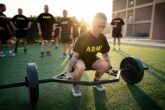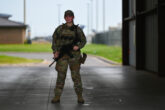September 20, 2018
Veterans: Answering the call to serve
In August, the veteran unemployment rate was 3.8 percent – the same as that for non-veterans – continuing a multi-year positive trend. The same month, Google announced that it was adding a feature allowing vets to plug their MOS into a job search to find suitable openings.
As with many initiatives designed to help veterans, this led me to a mixed reaction: while I’m pleased to see efforts to support my fellow veterans during our transitions out of the military and beyond, I am simultaneously frustrated at the ongoing perception that we, who volunteered to serve, now need to be served. For most veterans, service is connected with positive outcomes: we are less likely to live in poverty than those who have not served, and have higher education levels and wages. Not only that, but for many of us, the desire to serve continues beyond active duty. According to Got Your Six analysis, veterans volunteer, vote, donate to charity, and are involved with local communities at higher rates than non-veterans.
The volume of this volunteering is astonishing in scope and scale. To give just a few examples: In 2016, nearly 2,000 volunteers logged over 100,000 hours on Team Rubicon disaster relief operations around the globe. Nearly 7,000 American Legion volunteers collectively serve 900,000 hours annually at VA Medical Centers alone. Roughly 17,500 Mission Continues volunteers contributed nearly 200,000 hours of service in hundreds of communities nationwide in 2016. DAV volunteer drivers traveled over 18 million miles, providing over 600,000 rides to veterans and donating nearly 1.5 million hours of their time in 2017 alone.
This outpouring of service to – and with – our communities brings a sense of purpose and meaning that many feel we have lost when we leave the military, along with a deeper level of connection to others. Finding new ways to serve can be an important component of reintegration, with benefits accruing not only to others but also to the self. This has absolutely been true for me. It was deeply disorienting to transition out of my structured military life with its intimate personal connections and clearly defined mission to one in which I had to chart my own path in a city of strangers. Advocating for issues that mattered to me as part of a community brought gravity and focus that kept me moving forward.
Read the Full Article at The Hill
More from CNAS
-
National Security Human Capital Program
Short SupplyExecutive Summary The U.S. military faces a critical challenge: Fewer young Americans are willing to serve, and fewer adults are encouraging them to do so. Because of delibera...
By Katherine L. Kuzminski & Taren Sylvester
-
National Security Human Capital Program
Defending the Army’s Command Assessment ProgramThe concept for CAP — developed during the first Trump administration — benefited from the guidance, input and oversight from the foremost scholar and practitioner on military...
By Katherine L. Kuzminski
-
National Security Human Capital Program
‘Women Don’t Just Achieve…They Excel’: Fmr. Marine Corps Attack PilotDr. Kyleanne Hunter, former Marine Corps attack pilot and CEO of Iraq & Afghanistan Veterans of America, says “women are the fastest growing group of veterans” and “the fastes...
By Dr. Kyleanne Hunter
-
National Security Human Capital Program
A Workforce Strategy for America’s Shipbuilding FutureThe future of American maritime dominance will not be determined solely by the number of ships launched or contracts signed, but rather by the strength and sustainability of t...
By Katherine L. Kuzminski & Laura Schmiegel




